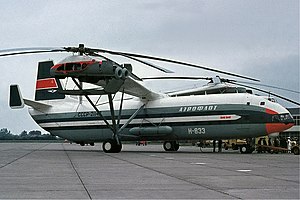Mil V-12
| V-12 | |
|---|---|
 |
|
| Mil V-12 at Groningen Airport in 1971 | |
| Role | Heavy lift helicopter |
| Manufacturer | Mil Design Bureau |
| First flight | (27 June 1967 – unsuccessful hop) 10 July 1968 – first successful flight |
| Status | Prototypes tested, cancelled |
| Primary user | Soviet Union |
| Number built | 2 |
The Mil V-12 (NATO reporting name Homer), given the project number Izdeliye 65, is the largest helicopter ever built. The designation "Mi-12" would have been the name for the production helicopter, and was not applied to the V-12 prototypes.
Design studies for a giant helicopter were started at the Mil OKB in 1959, receiving official sanction in 1961 by the GKAT (Gosudarstvenny Komitet Po Aviatsionnoy Tekhnike - "state committee on aircraft technology") instructing Mil to develop a helicopter capable of lifting 20 to 25 t (44,000 to 55,000 lb). The GKAT directive was followed by a more detailed specification for the V-12 with hold dimensions similar to the Antonov An-22, intended to lift major items of combat materiel as well as 8K67, 8K75 and 8K82 inter-continental ballistic missiles (ICBM).
Design limitations forced Mil to adopt a twin rotor system but design studies of a tandem layout, similar to the Boeing CH-47 Chinook, revealed major problems. The single rotor layouts also studied proved to be non-viable, leading to the transverse layout chosen for the finished article.
The transverse rotor system of the V-12, which eliminates the need for a tail rotor, consists of two Mi-6 transmission systems complete with rotors mounted at the tips of the approximately 30 m (98 ft) span inverse tapered wings. Although the first use by Mil, the transverse system had been used by several of the early helicopters, including the Focke-Wulf Fw 61, Focke-Achgelis Fa 223 Drache and Kamov Ka-22 Vintokryl convertiplane.
Construction of the V-12 first prototype, after exhaustive testing with test-rigs and mock-ups including a complete transmission system, began at Panki in 1965. The airframe was largely conventional, using stressed skin construction methods with high strength parts machined from solid. The large fuselage accommodated the 28.15×4.4×4.4 m (92.4×14.4×14.4 ft) cabin and crew section in the extreme nose, housing pilot, co-pilot, flight engineer and electrical engineer in the lower cockpit, with the navigator and radio operator in the upper cockpit.
...
Wikipedia
